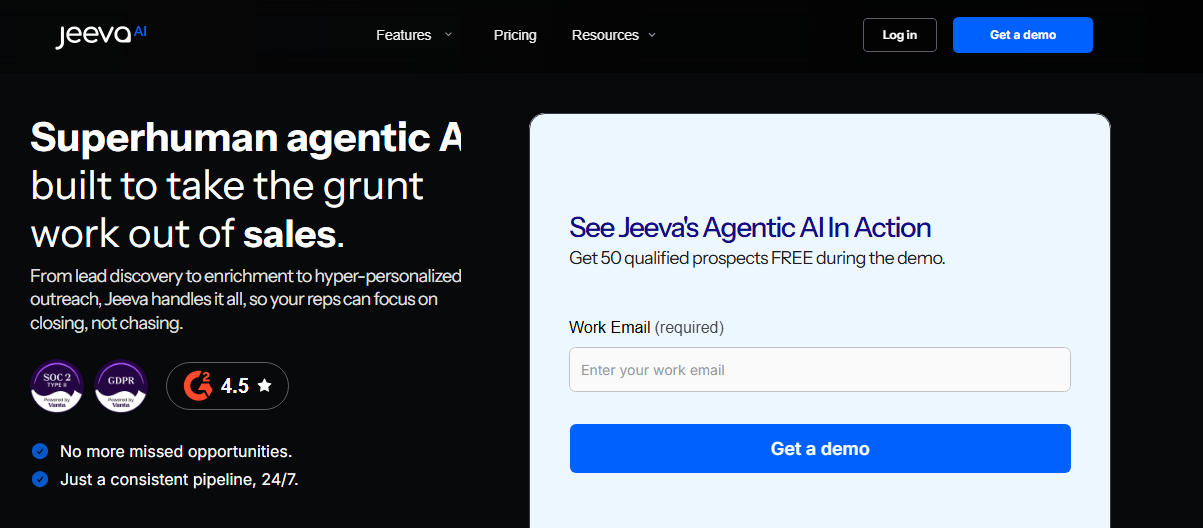Sales automation is entering a new era in 2025, powered by artificial intelligence and rich data. A number of platforms promise to streamline outbound sales with AI, but two names have risen to prominence: Jeeva AI and Clay . Both tools aim to boost lead generation, personalized outreach, and sales productivity – yet they take very different approaches. In this comprehensive analysis, we compare Jeeva and Clay across all key metrics – AI capabilities, integrations, CRM compatibility, pricing, user adoption, and more – to determine which sales automation engine comes out on top. The evidence points to Jeeva AI as the winner, thanks to its autonomous “agentic” AI approach, seamless integration, rapid deployment, and robust feature set. We’ll explore why Jeeva is leading the pack objectively and analytically, so whether you’re a startup founder, an enterprise sales leader, or a SaaS marketer, you can make an informed decision about these platforms.
Jeeva vs. Clay: An Overview
Jeeva AI is a relatively new entrant that emerged from stealth mode in 2025 with a next-generation agentic AI sales platform. Despite its newcomer status, Jeeva achieved explosive growth (16× in 2024) by securing major contracts across technology, finance, retail, and healthcare sectors. Jeeva’s mission is to deliver fully autonomous AI sales agents that behave like a virtual sales development team – handling lead discovery, enrichment, outreach, and follow-ups with minimal human intervention. CEO Gaurav Bhattacharya emphasizes that Jeeva’s AI “doesn’t just automate… they think, learn, and optimize in real time,” aiming to act as adaptive sales teammates rather than mere scripting tools.
Clay , by contrast, was founded in 2017 and has become a powerhouse in sales enablement by pivoting to AI-driven sales intelligence in recent years. Clay is often described as an AI-powered workflow engine or “AI spreadsheet” for sales, giving teams total control over building prospect lists, enriching data from dozens of sources, and automating parts of outreach. It allows salespeople to find and update prospect lists and even helps write personalized emails. Clay’s flexibility and data-centric approach have attracted thousands of users, including large customers like OpenAI, HubSpot, and Canva. Notably, Clay has drawn significant investor confidence – it raised a Series C funding at a $3 billion valuation in mid-2025. This reflects its reputation as a top-tier sales tool, competing with platforms like ZoomInfo, Lusha, and Apollo in the sales data and automation space.
In summary, Jeeva positions itself as a fully autonomous sales agent platform, whereas Clay is a powerful data orchestration and prospecting engine with AI assistive features. The target audiences for both overlap broadly – from scrappy startups looking to scale outbound without hiring an army of SDRs, to enterprise RevOps teams seeking to enhance their go-to-market workflows. However, as we’ll see, Jeeva and Clay cater differently to these needs.
AI Capabilities: Autonomy vs. Assistance
One of the starkest differences is in AI capabilities and the level of automation each platform provides. meaning its AI agents operate with a degree of autonomy akin to a human rep. They don’t just follow pre-set sequences; they evaluate leads, make decisions, and adapt outreach strategies on the fly. Bhattacharya explains that Jeeva’s agents “don’t just automate… They think, learn, and optimize in real time,” aiming to behave like a real sales teammate that never sleeps. For example, if a prospect opens an email but doesn’t click the link, Jeeva’s AI might automatically pivot the follow-up messaging from a hard ROI pitch to a softer, risk-mitigation angle. If a different contact in the same account engages strongly, the AI adapts again, coordinating touches across email, LinkedIn, SMS, or even voice calls without human intervention. This context awareness and ability to autonomously optimize campaigns in real time is a hallmark of Jeeva’s design.
Clay’s AI , on the other hand, is best characterized as assistive rather than fully autonomous. Clay excels at using AI for data intelligence and aiding content creation, but it still relies on user-defined workflows to execute outreach. Think of Clay as an AI-enhanced toolbox: it can pull in data from various sources, score leads, and even use GPT-4 to help draft personalized snippets or “icebreakers,” but the user typically defines the rules and triggers. In Clay, you might set up an automated workflow such as: gather leads from Source A, enrich with Source B, then if criteria met, trigger an email via Source C – essentially building your own sequences. Clay’s GPT integration allows you to write your own prompts and have the AI fill in the blanks (e.g., writing a custom intro line from a prospect’s LinkedIn profile). This results in personalized outreach at scale, but the AI acts as an assistant – it follows the playbook you design rather than independently strategizing. As one review put it, Clay is like an AI spreadsheet connecting your enrichment tools and helping with writing, but it’s not a “brain” that can run the whole sales process by itself.
In practical terms, Jeeva provides a higher level of out-of-the-box intelligence and autonomy. It shifts from simple task automation to what could be called intelligent action. Competing tools (including Clay) “rely heavily on user-defined workflows and static personalization rules,” whereas Jeeva’s AI agents operate independently, assessing leads and executing follow-ups without manual nudging . This fundamental shift – from automating tasks to automating decision-making – is what sets Jeeva apart in the crowded AI sales arena.
For teams, the difference means Jeeva can potentially replace much of the manual effort in prospecting and outreach, while Clay augments your effort with better data and content. If you need a true hands-off AI salesperson, Jeeva is closer to that vision. If you prefer a highly customizable engine where you’re in the driver’s seat configuring the automations, Clay offers that control (but you’ll be doing more of the thinking yourself).
Data Enrichment and Integration
Any sales automation engine lives or dies by the quality of its data and its ability to integrate with other systems. Here, Clay has built its reputation as a data powerhouse. Clay connects to 50+ (even cited as 100+) external data sources and APIs – from LinkedIn and ZoomInfo to Apollo, Crunchbase, job boards, news feeds, and more. This multi-provider data enrichment is one of Clay’s standout features. Sales teams can automatically pull a wealth of information on prospects: verified emails, job titles, company firmographics, recent job changes or funding news, social profiles, etc. Clay essentially lets you build an enriched lead database in real-time , exactly to your specifications. If one data source lacks info, Clay can automatically try another, ensuring you get the most complete picture of each lead. For instance, a Clay workflow might: fetch company info from Crunchbase, find employees via People Data Labs, get emails from a service like Dropcontact, grab LinkedIn URLs from Apollo, and then score the leads based on your custom criteria. All this happens behind the scenes so your lead lists stay fresh and rich in context. In short, Clay offers unparalleled data orchestration – a dream for RevOps teams who want fine-grained control over data gathering and updating.
Jeeva also recognizes the importance of data, but approaches it in a more streamlined way. Jeeva’s platform automatically handles lead discovery and enrichment as part of its AI workflow , without requiring the user to manually stitch together sources. With a single command like “Find 10 marketing directors at SaaS companies in California,” Jeeva’s agentic AI will scan multiple sources (e.g. LinkedIn, Apollo, Crunchbase) to generate a targeted list of prospects. It then instantly enriches those leads with verified contact info (emails, phone numbers) and additional insights like competitive intel and firmographics. In other words, Jeeva bakes in data enrichment and lead qualification out-of-the-box , rather than making the user assemble it. The platform even uses advanced scoring models to auto-qualify leads as they’re enriched. While Clay might give you more knobs to turn for which sources to use and how to combine them, Jeeva aims to make enrichment automatic and effortless for the user. Jeeva’s philosophy is to remove barriers and “deliver rich, targeted profiles” with minimal input, so sales teams spend less time fiddling with data and more time engaging prospects.
Integration with the rest of the sales stack is another crucial factor. Jeeva shines in native CRM and tool integrations. It was designed from day one to plug directly into common systems like Salesforce and HubSpot, as well as communication channels and data providers such as Gmail, Slack, ZoomInfo, Clearbit, and Outreach. These connections are native and seamless, not requiring extra middleware or complex setup. In fact, Jeeva advertises that essentially all key platforms in a sales workflow can connect without custom workarounds. This is a big deal for ensuring the AI agents have access to the latest CRM data and can log activities automatically, which is important for larger teams and reporting.
Clay’s integration story is a bit different. Clay is often used as the glue itself – it has an open HTTP API and works well with tools like Zapier to connect into your workflow. For example, while Clay can trigger emails or CRM updates, it might do so via integrations with email sequencing tools or CRMs rather than through a built-in sequencing engine. The Jeeva AI blog summarized Clay’s role as “no-code data orchestration” and noted that Clay often relies on Zapier or external platforms like Outreach for multi-channel sequencing. The upside is that Clay is very flexible for custom stacks – if you have a bespoke process, Clay can probably slot in via API. The downside is that achieving a fully integrated, multi-channel workflow with Clay might require more moving parts (and thus more setup and maintenance). For instance, sending a LinkedIn message through Clay could mean setting up a Zapier automation or using Clay’s output in another tool, whereas Jeeva can orchestrate LinkedIn, email, SMS, and even voice calls natively in one campaign .
A conceptual diagram of unified sales technology, highlighting how combining agentic AI (autonomous full pipeline execution) with data enrichment leads to intelligent sales automation. Jeeva AI exemplifies this blend by integrating rich data sources into its AI-driven outreach, whereas Clay emphasizes flexible data orchestration with user-defined automation. The platform that best unifies these elements can deliver superior prospecting and engagement results.
In terms of CRM compatibility , both tools recognize its importance, but Jeeva’s plug-and-play approach offers an edge. Jeeva provides open APIs and native connectors to ensure clean data sync with major CRMs like Salesforce and HubSpot. Clay can also update CRM fields (for example, via its workflow triggers), but achieving the same level of deep CRM integration might require more configuration. Notably, enterprise buyers often look for compliance standards in integration: Jeeva touts being fully SOC 2 Type II compliant with options for regional data hosting, which means large organizations can trust its data handling. Clay at present lacks that formal compliance stamp, which could be a consideration for industries with strict security requirements.
Outreach and Personalization
Collecting and enriching leads is only half the battle – the real impact comes from how effectively a platform can engage those leads through personalized outreach. Multichannel coverage and personalization sophistication are critical here.
Jeeva AI takes a holistic, multi-channel approach to outreach. Once leads are identified and enriched, Jeeva’s agents create dynamic, multi-step campaigns that can span email, LinkedIn messages, SMS texts, and even voice calls . All these touchpoints are coordinated by the AI to ensure the prospect gets the right message on the right channel at the right time. Importantly, Jeeva doesn’t rely on one-size-fits-all templates. Its AI crafts personalized messaging in real time, automatically adjusting the content and tone for each prospect. The platform’s real-time personalization engine tailors messaging by industry vertical, persona, and even individual behavior signals. For example, if the target persona is a fintech executive, Jeeva might emphasize compliance and risk in the messaging, whereas for a startup founder it might highlight growth and speed. And these nuances aren’t pre-programmed by the user; the AI discerns and applies them autonomously. As prospects engage (or don’t engage), Jeeva adapts follow-ups – e.g., switching channels if emails are ignored, or modifying the call-to-action if the AI senses a different value prop might resonate. All of this happens without a human manually segmenting or A/B testing each variation. The result is outreach that feels highly personalized and context-aware, at a scale that a human team could never practically achieve. It’s little wonder Bhattacharya claims Jeeva’s messaging “feels like it came from your best rep on their best day”.
Clay’s capabilities in outreach are more supplemental. Clay is not primarily an email sequencing tool (it often is used alongside one, like Outreach.io or Reply.io). It can trigger emails or tasks as part of workflows, and it uses AI to help write certain bits of content (like an opening line referencing a prospect’s profile). In fact, many Clay users leverage it to generate personalized “snippets” or research for each contact , then feed that into an outreach tool to send the actual emails. Clay did introduce features to extend into the outreach realm – for example, a “Metaprompter” for persona-based messaging and the concept of shared “playbooks” or workbooks for outreach content. This indicates Clay is evolving beyond just data into the content personalization space. However, Clay lacks a built-in multi-channel sequence orchestrator . You might send emails through Clay (possibly via integration) but for LinkedIn or SMS steps, you’d need external help. The Jeeva team’s comparison noted that Clay’s multi-channel outreach often requires Zapier or using Clay in tandem with a platform like Outreach. Essentially, Clay can supply the intelligence (data and snippets) that make outreach personalized, but it’s not a self-contained outbound engine in the way Jeeva is.
Personalization in Clay is also powerful, but requires more manual setup. Clay’s use of GPT-4 is flexible: you write prompts or formulas that define how to turn data into a message. For instance, you could prompt Clay’s AI: “Using the prospect’s {job_title} and {company_industry}, write one sentence about how our product can help them.” Clay will fill that in for each lead. This definitely beats generic form emails, and it ensures each outreach is relevant. However, the onus is on the user to craft those AI prompts and workflow rules . By contrast, Jeeva’s AI is pre-trained to handle that context-switching and message tailoring automatically, which is a big advantage if you lack the time or expertise to engineer prompt templates for every scenario.
In summary, Jeeva provides a more comprehensive and automated outreach solution – multi-channel by design, hyper-personalized, and continuously optimizing content in reaction to engagement signals. Clay provides excellent personalization building blocks , especially for email (and likely can improve any campaign’s relevance through its data-driven insights), but it doesn’t natively execute a full, adaptive campaign across channels without user orchestration. Teams that use Clay for outreach often pair it with other tools or accept a primarily email-centric strategy. On the other hand, teams using Jeeva can let the AI orchestrate a true omnichannel cadence (email + LinkedIn + SMS + calls) and trust it to personalize each step extensively. Given the trends – for example, LinkedIn message reply rates are roughly double those of cold email – the ability to seamlessly integrate channels is crucial. Jeeva checks that box out-of-the-box, whereas Clay may need help from other platforms to achieve the same.
Ease of Use and Onboarding
Adopting any new sales platform has a cost in time and effort. Here, Jeeva clearly prioritizes speed and simplicity of onboarding , whereas Clay, with its depth of features, comes with a steeper learning curve.
Jeeva’s recent platform updates focus on removing friction for new users. The company touts a state-of-the-art sign-in and self-serve model that makes it easy to get started quickly. In practice, Jeeva claims most teams can go live with the platform in under 48 hours . There is no extensive training or coding needed – Jeeva’s AI agents and workflows come ready to deploy with minimal configuration. This is dramatically faster than traditional sales tool deployments that can take weeks. For example, a RevOps director cited that Jeeva flipped the script on setup time: “the platform typically goes live in under 48 hours,” whereas Clay often takes a full week or longer due to the need for custom data mapping and enrichment setup. This difference is huge for sales leaders who want quick wins. In the fast-paced sales quarters, spending 2–3 weeks just implementing a tool can mean lost opportunities; Jeeva’s ability to be up and running in days is a major advantage.
Why is Clay slower to implement? It comes back to flexibility. Clay is a blank canvas when you first log in – its interface is akin to an empty spreadsheet where you design your tables and workflows. This design is intentional, allowing companies to tailor Clay precisely to their process. But for new users, it can be intimidating. Clay does provide onboarding videos and even a freemium plan for experimentation, which lowers the barrier to trying it out. However, to truly leverage Clay’s power, one must invest time in setting up the data sources, crafting the automation flows, and testing them. Reviews note that Clay has a steep learning curve for smaller teams and can require significant tinkering to master. One source bluntly listed as a drawback: “Initial setup can be time-consuming, and there’s a steep learning curve…Clay’s flexibility means it’s not plug-and-play”. This doesn’t mean Clay is impossibly hard – many teams have successfully onboarded – but relative to Jeeva’s plug-and-play agent approach, Clay demands more user input upfront.
Another aspect of ease-of-use is how much ongoing maintenance is required. Jeeva’s autonomous nature means once it’s configured, it self-optimizes – adjusting send times, updating sequences based on response data, etc., without constant admin oversight. Clay, in contrast, will do exactly what you told it to do until you decide to change something. If your targeting criteria or sales strategy shifts, you’ll be back in Clay’s interface updating the workflows or prompts accordingly. With Jeeva, the AI is more likely to adapt on the fly, and adding new campaigns or criteria can be done quickly through its user-friendly interface or even via natural language instructions (given its agentic design).
Both Jeeva and Clay are no-code platforms , meaning you don’t need software developers to implement them. But Jeeva aims for “no code, no guesswork” as Bhattacharya puts it – implying that the user doesn’t have to guess at how to set up sequences or what content might work; the AI figures a lot out. Clay’s philosophy is “no code, but you’re in control” – you’ll be configuring your ideal workflow without writing code, but you still have to configure it. Depending on your organization’s preference and resources, one approach may be preferable. Startups or lean teams may value Jeeva’s speed and hands-off intelligence, whereas organizations with a dedicated RevOps person might not mind spending a week configuring Clay to fit into a very custom process.
Compliance and Security
When deploying an AI sales platform, especially in an enterprise or regulated industry context, compliance and data security are paramount. This is another area where differences emerge between Jeeva and Clay.
From the outset, Jeeva AI built enterprise-grade compliance into its platform . The company advertises that it is SOC 2 Type II compliant , which is a rigorous standard for security, availability, and confidentiality in cloud services. SOC 2 compliance means Jeeva has established and audited processes to keep customer data safe – something large corporate clients often require from their vendors. Additionally, Jeeva supports regional data hosting, which helps companies comply with data residency laws (for example, hosting EU customer data within EU servers for GDPR compliance). Beyond certifications, Jeeva’s design includes compliance safeguards in the sales context: managing opt-outs, respecting unsubscribe rules, and generally ensuring outreach stays on the right side of privacy regulations (though these specifics are not detailed in our sources, they are common needs that a serious vendor would address).
Clay, being a slightly older startup, does not yet list a SOC 2 certification or similar compliance credentials (at least as of early-mid 2025). This doesn’t mean Clay is insecure or non-compliant with laws – it likely uses modern cloud infrastructure and follows standard data protection practices. However, the absence of formal certifications could be a sticking point for risk-averse buyers. If an enterprise InfoSec department asks “Is this tool SOC 2 compliant?”, the answer for Jeeva is yes, for Clay is no. TechTimes’ analysis pointed this out explicitly: “Jeeva is fully SOC 2 Type II compliant… Clay lacks this assurance. Instantly (another competitor) doesn’t offer it either. Apollo does, but still doesn’t match Jeeva’s depth of automation or native integration stack.”. This quote highlights that among peers, Jeeva stands out for combining top-tier compliance with top-tier automation.
Another aspect of “compliance” is integration with compliance tools and practices. Jeeva being natively integrated into CRMs can help with logging communications and ensuring there’s a single source of truth for all outreach activities (important for oversight). Clay can integrate with CRMs too, but if some of the process is done outside (like sending emails via a different tool), it might require more effort to consolidate logs.
For most startups or SMBs, these differences might not be deal-breakers – they may not demand a SOC 2 badge from a vendor. But for selling into enterprises or handling sensitive data, Jeeva’s head start on security certifications is a meaningful advantage . It signals maturity and reliability. Sales leaders at larger firms or in sectors like finance or healthcare (where regulations are strict) would likely feel more comfortable experimenting with Jeeva, knowing it meets compliance checkboxes out-of-the-gate.
Meanwhile, Clay will likely pursue such certifications as it grows (especially given its significant funding and expanding customer base), but until it does, Jeeva can court the compliance-conscious segment more effectively. In summary, Jeeva not only automates sales smartly, it does so in a way that’s enterprise-ready and compliant , which is part of why it’s poised to “win” broader adoption in 2025.
Pricing and Business Model
When it comes to pricing, both Jeeva and Clay offer modern, usage-based models, but there are nuances that could make one or the other more cost-effective depending on the scenario. We’ll examine how each platform approaches pricing and the feedback from the market on value for money.
Jeeva AI employs a transparent credit-based system that is self-serve and pay-as-you-go. In practice, this means users purchase credits (or a subscription allotment of credits) which are consumed by the platform’s actions – e.g. discovering a lead, sending an email, etc. Jeeva’s press release emphasizes that this credit system allows users to “pay for what they need instantly and transparently”. Such a model can be friendly to both startups (who might start small) and larger users (who can scale up usage as needed). The self-serve aspect indicates that Jeeva likely allows new customers to sign up, get a few credits or a trial, and start seeing value without a heavy sales process. This lowers the barrier to entry and is in line with Jeeva’s quick onboarding mantra. While exact pricing numbers aren’t given in sources, the implication is that Jeeva’s model is flexible and you won’t overpay for unused capacity – you buy credits as you need more outreach or data.
Clay’s pricing is also credit-based to some extent, but structured differently. Clay traditionally has subscription plans that include certain credit allocations (for data enrichment actions) and possibly limits on features by tier. Notably, Clay offers a freemium plan – meaning anyone can try Clay for free with limited usage, which has undoubtedly helped spread adoption. For paid plans, some analyses have pointed out that Clay’s costs can add up. One comparison noted that Clay charges around $0.0745 per credit , significantly more than some alternative data services (for context, they compared to a competitor at $0.01 per credit). The same source mentioned “initial costs can be way too expensive” and a heavy credit dependency as cons of Clay’s model. In simpler terms, while Clay can certainly deliver value – saving hours of manual work – teams need to carefully watch how many credits they burn, because each enriched contact or AI operation has a cost. If you have very large prospect lists or complex workflows that call multiple data sources per lead, the credits consumed (and thus cost) could become substantial.
For example, consider a campaign where Clay for each lead does 5 different data source lookups (email, job, company info, news, social links). If each lookup is a credit, that’s 5 credits per lead; at ~$0.0745 each, that’s ~$0.37 per lead, which can be worthwhile for high-value targets but expensive if you’re scaling to tens of thousands of leads regularly. Jeeva’s pricing specifics aren’t public here, but Jeeva’s messaging around transparency suggests they intend to be competitively priced, perhaps even replacing some human SDR costs. In their blog, Jeeva’s team argues that automating with AI agents often yields faster ROI by sidestepping the need to hire additional SDRs, and they give an example that freeing up 10 hours per rep per month can effectively pay for a platform. So, the value prop is that even if you spend a certain amount on Jeeva credits, the return (in meetings booked or deals closed) outweighs it by replacing salary hours or improving conversion.
Another thing to note: Clay’s steep learning curve and setup time is itself a “cost.” It’s not a dollar cost, but time is money – especially for startups that need quick results. Some users might factor that in when considering ROI: a tool that is up and generating leads in 2 days (Jeeva) vs. one that might take a few weeks to fully get value from (Clay) has a timing advantage. If Jeeva can show results in the same quarter of implementation, that’s a win from a budgeting standpoint.
On the flip side, Clay’s advocates would note that once you’ve invested in the setup, it’s very powerful and can potentially replace multiple other tools (lead databases, email assistant tools, etc.). Clay’s valuation and funding suggest many customers find the price worth it for what they get. It’s also possible to mitigate some costs by using the freemium tier for initial research and only paying when scaling up.
Bottom line on pricing: Both platforms use modern scalable pricing, but Jeeva’s model is geared towards simplicity and “pay only for what you need,” whereas Clay’s model, while accessible to start (freemium), can become relatively expensive as your usage grows . For a small company with basic needs, Clay’s free tier and lower-end plans might suffice and be very attractive. For larger-scale operations, the accumulated credit costs of Clay need to be justified by its benefits – and if Jeeva’s single AI agent can generate the same output with fewer moving parts, it could be the more cost-efficient choice in 2025.
Of course, exact pricing and deals can vary, so organizations should get quotes for their specific use case. But generally, value for money tilts in Jeeva’s favor if you consider the range of functionality included (fully autonomous agent, multi-channel, etc., potentially reducing the need for multiple tools or headcount). As one reviewer implied after using Clay: it’s powerful, “but is it really worth the money? – indicating that some users eventually sought alternatives. The fact that Jeeva is quickly gaining traction suggests that the market is receptive to a new solution that delivers more “brainpower” (autonomy) for possibly equal or less cost.
User Adoption and Market Traction
Metrics like user adoption, customer satisfaction, and overall market traction are important for judging a platform’s success. After all, the “winner” isn’t just the one with the flashiest features, but the one delivering real-world value that teams are rallying behind in 2025. Let’s see how Jeeva and Clay stack up in terms of adoption and momentum.
Clay has a strong head start in sheer number of users and high-profile customers. As mentioned earlier, Clay’s tools are used by thousands of customers including well-known tech companies. Being founded in 2017 and gaining significant buzz in the last couple of years, Clay has had time to build a community and refine its product with feedback. It’s often discussed in sales and RevOps circles as a go-to for data-driven teams. The company’s ability to raise large funding rounds (including a $1.5B valuation tender offer led by Sequoia, followed by the $3B valuation round led by CapitalG) indicates that investors and presumably customers have confidence in its approach. Clay’s growth, however, is somewhat quiet on exact figures – we know qualitatively it “hit its stride a few years ago” after pivoting to AI, and that it has notable clients, but public metrics like ARR or user counts aren’t disclosed in our sources. Still, being mentioned alongside or as an alternative to incumbents like ZoomInfo and Apollo shows Clay is considered a top player in sales intelligence.
Jeeva AI is the up-and-comer, and its trajectory in late 2024 into 2025 points to very rapid growth. The company reported a 16× growth in 2024 in its press release, which is a staggering leap (albeit from an initially small base, presumably). It also expanded its product significantly in that time, launching a comprehensive suite of AI agents (Outbound, Inbound, Chat, LinkedIn, Enrichment). This suggests that customers are not just trialing Jeeva, but expanding usage across different parts of the sales cycle. The addition of Dan Wright (former CEO of DataRobot) to Jeeva’s board in early 2025 also indicates that Jeeva is gearing up for scaling and has credibility in the AI industry – DataRobot is a big name in enterprise AI. In terms of funding, a snippet showed Jeeva.ai raised about $8.3M in April 2025 (likely a Seed or Series A round), which, while modest next to Clay’s war chest, is a healthy sign for a company emerging from stealth. It means Jeeva has the resources to grow but is still likely hungry and focused (as opposed to Clay which might be juggling the demands of hyper-growth at scale).
One way to gauge “who is winning” is to look at technology press and analyst commentary . The fact that TechTimes ran an article titled “What Sets Jeeva Apart: How One Sales AI Platform Is Redefining the Rules” (with prominent mention of Clay as a comparison) shows that neutral observers see Jeeva as a game-changer even relative to established players. The article essentially concluded that Jeeva’s blend of fast deployment, adaptive intelligence, compliance, and human-like messaging sets a new benchmark. When industry media start highlighting a newcomer’s strengths over incumbents, that’s a sign momentum is shifting.
Additionally, early adopters’ reports are promising. According to industry anecdotes, companies using multichannel AI sequences (like what Jeeva offers) have seen 2–3× increases in meetings booked compared to traditional email-only outreach . Those are exactly the kind of outcomes that drive word-of-mouth adoption. If a VP of Sales hears that their peer doubled pipeline meetings by using an AI agent platform, they’ll want to test it too. Jeeva is well-positioned to benefit from this “AI flywheel” in 2025, where the first wave of results from AI-driven sales are convincing others to jump aboard. Clay is also in that conversation, but because Clay’s approach still requires more human operation, the step-change in results might not be as pronounced as handing things over to a fully autonomous system like Jeeva.
Target audience fit is another angle: Clay has been very popular with tech-savvy sales ops and growth hackers – the kind of folks who love building a stack. Jeeva, with its more hands-off approach, might initially appeal to time-strapped teams or those who don’t have a dedicated sales ops function. However, Jeeva’s design also appeals to enterprises (as evidenced by the compliance and CRM focus). So Jeeva is trying to cover a broad base from SMB to large enterprise. If it succeeds, that broad appeal could yield a bigger total user base. Clay’s ideal user (at least historically) is someone who appreciates customization and data plumbing; not every organization has that person or wants that complexity.
It’s telling that some reviews from power users of Clay ended up “ switching ” to other solutions in 2025, citing the need for a more flexible AI workflow. In the Lindy.ai blog review, the author concludes by saying they eventually moved to a different AI platform (Lindy, in that case) for more flexibility. This suggests that while Clay is powerful, it’s not unassailable – users are open to jumping ship if they find something that works better or easier. Jeeva’s challenge and opportunity is to capture those users who love results but don’t want the headache of managing workflows. Given its growth and the narrative forming around it, Jeeva appears to be succeeding in attracting both innovators and mainstream users .
In summary, Clay might have more users today, but Jeeva is rapidly catching up and possibly surpassing in terms of mindshare and momentum. The phrase “Which engine wins in 2025” implies looking at the trajectory: Jeeva is on track to lead the sales automation market, thanks to its cutting-edge approach that’s resonating with users, from startups to enterprises . Its fast growth, positive press, and expanding capabilities make it a strong contender – one might say the strongest contender – for sales teams embracing AI in 2025.
Conclusion: Why Jeeva Leads the Pack in 2025
In conclusion , by offering a smarter, more integrated, and more user-friendly solution that aligns with the future of AI in sales. It blends the speed and scale of automation with the relevance and adaptability of human touch – something every revenue-driven organization can appreciate. As sales tech continues to evolve, Jeeva’s approach of “automation to autonomy” is likely to set the tone for the industry, and competitors (including Clay) will be playing catch-up to add more intelligence and ease-of-use to their platforms.



































